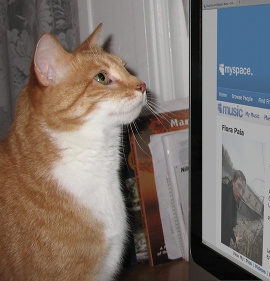Introduction to the myths
A fun way to teach the basics of genetics is to have students look at traits on themselves. Just about every biology student has, in one class or another, been asked to roll their tongue, look at their earlobes, or check their fingers for hair. Students can easily collect data on several different traits and learn about genes, dominant and recessive alleles, maybe even Hardy-Weinberg proportions. Best of all, these data don't require microscopes, petri dishes, or stinky fly food.
Unfortunately, what textbooks, lab manuals and web pages say about these human traits is mostly wrong. Most of the common, visible human traits that are used in classrooms do NOT have a simple one-locus, two-allele, dominant vs. recessive method of inheritance. Rolling your tongue is not dominant to non-rolling, unattached earlobes are not dominant to attached, straight thumbs are not dominant to hitchhiker's thumb, etc.
In some cases, the trait doesn't even fall into the two distinct categories described by the myth. For example, students are told that they either have a hitchhiker's thumb, which bends backwards at a sharp angle, or a straight thumb. In fact, the angle of the thumb ranges continuously, with most thumbs somewhere in the middle. This was clearly shown in the very first paper on the genetics of hitchhiker's thumb (Glass and Kistler 1953), yet 60 years later, teachers still ask students which of the two kinds of thumb they have.
In other cases, the trait really does fall into two categories, but it isn't determined by genetics. For example, students are asked to fold their arms, then told that the allele for having the right forearm on top is dominant. It is true that most people fall into two categories, right arm on top or left arm on top, but the very first study on the subject (Wiener 1932) clearly demonstrated that there is little or no genetic influence on this trait: pairs of right-arm parents are just about as likely to have right-arm children as are pairs of left-arm parents.
Some traits, such as tongue rolling, were originally described as fitting a simple genetic model, but later research revealed them to be more complicated. Other traits were shown from the very beginning to not fit the simple genetic model, but somehow textbook authors decided to ignore this. A quick search in the standard reference on human genetics, Online Mendelian Inheritance in Man (OMIM), makes it clear that most of these traits do not fit the simple genetic model. It is an embarrassment to the field of biology education that textbooks and lab manuals continue to perpetuate these myths.
Who's my daddy?
Teachers might argue that using traits like tongue rolling and arm folding to teach genetics is a useful "lie-to-children," an oversimplification that is useful for teaching beginners, like teaching physics students that electrons are particles that rotate around the nucleus of an atom in little circular orbits. They can learn about polygenic traits, incomplete penetrance, and environmental effects in later biology classes, at the same time they're learning the quantum model of electrons in their physics classes.
However, there is another problem with teaching inaccurate human genetics. Let's say you tell your students that arm folding is a genetic trait, with the allele for right forearm on top (R) being dominant to left forearm on top (L). Results from a large number of studies show that about 11 percent of your students will be R children of two L parents; if they understand the genetics lesson correctly, they will think that either they were secretly adopted, or Mom was fooling around and Dad isn't their biological father. More of your students will reach this conclusion with each bogus genetic trait that you add to the lesson. I don't think this is a good way to teach genetics.
It is possible to use accurate genetic traits for a classroom exercise, such as blood types or DNA markers. However, some children are not the biological offspring of the people they think they are. The most common cause of this is a woman having an affair with someone other than her husband or partner. Several genetic studies, mostly in European and North American populations, have found that the rate of this "paternal discrepancy" is about 4 percent of all children (Bellis et al. 2005), which means that a typical classroom is likely to have at least one child who doesn't know that the person they call "Dad" isn't their biological father. Less commonly, children are not told they are adopted or are the product of artificial insemination or egg donation. So if you use blood groups or DNA for a classroom exercise in genetics, some of your students may find out that their family belongs on a lurid daytime talk show. While it can be medically important to know who your biological parents really are, a simple classroom demonstration of introductory genetics is not the way to learn this potentially traumatic information.
Alternatives
I prefer to use cat coat genetics to teach basic genetic concepts, because there are several easily visible traits whose genetics is well-established by cat breeders. Christensen (2000) gives an excellent description of a lesson in which each student in a large class records information on one cat they see in person, then he collects and analyzes the data. I teach a small class and have my students use Petfinder.com to look at pictures of large numbers of cats up for adoption in different cities; that way, they can look for geographic variation in allele frequency. It is fairly easy to score several different traits from photographs (although seeing the cats in person is better), and if the students don't have access to computers, you can ask each student to describe the cat they know best. My experience has been that even students who don't own a cat have a friend's or neighbor's cat that they can describe with sufficient accuracy from memory.
Here are the easiest cat coat traits for students to identify. There are other traits that are rare (Siamese, polydactyly), difficult to score in photographs (agouti), or more complicated (genes affecting color patterns).
| Locus | Genotypes | Phenotypes |
|---|---|---|
| L (hair length) | LL Ll ll | short hair short hair long hair |
| W (white) | WW Ww ww | completely white hair completely white hair some colored hair |
| S (piebald spotting) | SS Ss ss |
some white hair some white hair no white hair |
| D (dense pigment) | DD Dd dd | black, brown or orange black, brown or orange gray, light brown or cream |
| O (orange) | OO (♀) or O- (♂) Oo (♀) oo (♀) or o- (♂) | orange or cream orange and black, or cream and gray black or gray |
At the hair length locus, there are some suggestions in the literature that the allele for long hair is more common in colder areas; this is something students can investigate using pictures of cats from different cities.
The white locus is useful because the dominant W allele, which produces all-white cats, is quite rare; this helps students understand that a "dominant" allele, in genetics, is one that determines the phenotype of the heterozygote, not the most common allele in the population. The spotting, dense, and orange loci cannot be scored in cats with the W allele.
At the spotting locus, the amount of white color in cats with the S allele can range from a few white toes, to white everywhere except for a colored patch on the forehead or tail. Some sources say that S/s heterozygotes have white on less than 50 percent of the body, while S/S homozygotes have white on more than 50 percent; it would be interesting for students to investigate this and see whether cats fall into three discrete categories (no white, much less than 50 percent white, much more than 50 percent white) or if there are a lot of cats with intermediate amounts of white. The pattern and amount of white may be affected by developmental accidents and modifier genes (see here for much more information).
The dense pigment locus can be hard to score in badly lit photographs, but is pretty clear when you see the cat in person.
The orange locus is sex-linked (it is on the X chromosome). In the United States, cats with orange and black patches are called "calico" if they also have white from the spotting locus and "tortoiseshell" if they don't have white; in Australia, both kinds are called "tortoiseshell" or "torties." Male calico or tortoiseshell cats are extremely rare and are generally found in XXY males. Because all three genotypes can be distinguished in females, it is possible to test a sample of cats for fit to Hardy-Weinberg proportions.
Summary for worried parents
For each of these human traits, there is a myth that one form is recessive. If that were true, two parents with the recessive trait could not have a child with the dominant trait. Here's a quick listing of the reality about each of these.
Can two parents who fold their arms with the left arm on top have a child who folds with the right arm on top? Yes.
Can two parents with attached earlobes have a child with unattached? Yes.
Can two parents who produce red urine after they eat beets have a child who makes yellow beet urine? Yes.
Can two parents with straight pinkies have a child with a bent pinkie? Yes.
Can two parents with smooth chins have a child with a cleft chin? Yes.
Can two parents without a bump inside their ear ("Darwin's tubercle") have a child with this bump? Yes.
Can two blue-eyed parents have a child with brown, green or hazel eyes? Yes.
Can two red-haired parents have a child with blond or brown hair? Yes.
Can two parents whose hair whorls counterclockwise on the back of their head have a child whose hair whorls clockwise? Yes.
Can two parents who clasp their hands with the left thumb on top have a child who clasps hands with the right thumb on top? Yes.
Can two parents with hitchhiker's thumbs have a child with straight thumbs? Yes.
Can two parents without mid-digital hair have a child with hair? Yes.
Can two parents who cannot taste the bitter compound PTC have a child who can taste it? Yes.
Can two parents with the big toe longer than the second toe have a child with the big toe shorter than the second toe? Yes.
Can two parents who cannot roll their tongues have a child who can? Yes.
Can two parents without dimples have a child with dimples? Probably, but no real research has been done.
Can two parents without a widow's peak have a child with a widow's peak? Probably, but no real research has been done.
Can two parents who produce non-stinky urine after they eat asparagus have a child who makes stinky asparagus urine? Maybe not; more research is needed.
Can two parents with dry earwax have a child with wet earwax? No (or at least it's very rare).
References
Bellis, M. A., K. Hughes, S. Hughes, and J. R. Ashton. 2005. Measuring paternal discrepancy and its public health consequences. Journal of Epidemiology and Community Health 59: 749Ð754.
Christensen, A. C. 2000. Cats as an aid to teaching genetics. Genetics 155: 999-1004.
Glass, B., and J. C. Kistler. 1953. Distal hyperextensibility of the thumb. Acta Genetica 4: 192-206.
Wiener, A. S. 1932. Observations on the manner of clasping the hands and folding the arms. American Naturalist 66: 365-370.
Return to John McDonald's home page
This page was last revised October 29, 2012. Its address is http://udel.edu/~mcdonald/mythintro.html. It may be cited as pp. 1-5 in: McDonald, J.H. 2011. Myths of Human Genetics. Sparky House Publishing, Baltimore, Maryland.
©2011 by John H. McDonald. You can probably do what you want with this content; see the permissions page for details.



